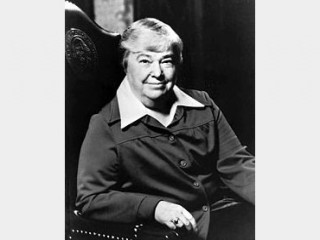
Dixy Lee Ray biography
Date of birth : 1914-09-03
Date of death : 1994-01-03
Birthplace : Tacoma, Washington, USA
Nationality : American
Category : Famous Figures
Last modified : 2011-02-22
Credited as : Marine biologist, and U.S. governor of Washington, Atomic Energy Commission
Dixy Lee Ray was a marine biologist interested in environmental issues. Concerned about the energy supply, she was appointed to the Atomic Energy Commission. After also serving in the State Department, she was elected to one term as governor of Washington.
Dixy Lee Ray was born in Tacoma, Washington, on September 3, 1914. Her parents, Alvin Marion Ray, a commercial printer, and Frances (Adams) Ray, already had one daughter and could not decide on another girl's name. The birth certificate read simply "Baby Ray, female." As she grew up, she was affectionately called "the little Dickens," later shortened to Dick. When she turned 16 she chose her own name, taking Dixy in place of Dick and picking Lee for her Southern grandmother, who was related to General Robert E. Lee.
Dixy Lee Ray graduated from high school with an outstanding record and several scholarship offers. She picked Mill's College, a women's school in Oakland, California, where she paid her way waiting tables and painting fences and houses. A strong, sturdy girl, she relished jobs that called for muscle.
Although Ray began her college career studying drama and theater, she soon switched to science. Tide pools fascinated Ray, perhaps because as a child she had vacationed on Puget Sound. She earned her Bachelor's degree in zoology Phi Beta Kappa in 1935 and received a Master's degree and a teaching certificate the following year.
Ray liked teaching and remained in Oakland until 1942, teaching science in the public schools and working part-time on her doctoral degree by traveling to Stanford University's Hopkins Marine Biological Station in Pacific Grove on weekends. In 1942-1943 a fellowship allowed her to pursue her doctorate on a full-time basis. In 1945 she received her Ph.D. and took a position in the zoology faculty of the University of Washington in Seattle.
In her 27 years at the University of Washington, Ray addressed herself to environmental issues relating to the sea. She served on numerous scientific and governmental panels dealing with oceanography and sailed as chief scientist aboard the Stanford research ship Te Vega on the International Indian Ocean Expedition. In 1963 she became director of the Pacific Science Center in Seattle. Under her direction the center evolved into a multipurpose facility, including a museum, laboratories, and a center for scientific symposia. Ray also became a local television personality when she developed a weekly series called "Animals of the Sea," which proved a great popular success. In 1967 Seattle named Ray its Maritime Man of the Year in recognition of her success in bringing science to the people.
In 1972 President Richard M. Nixon appointed Ray to the Atomic Energy Commission (AEC). A marine biologist, not a nuclear physicist, Ray at first seemed an odd choice. But she was already deeply concerned about the nation's energy supply and brought to her new position a keen interest in nuclear power. On her way to Washington to accept her appointment she drove across the country so that she could inspect nuclear power stations.
In 1973 Ray became chairperson of the AEC. A colorful and often controversial figure, Ray championed the expansion of nuclear power facilities and often found herself at odds with environmentalists. Convinced that nuclear power could be made absolutely safe, she urged construction of more nuclear power plants. In Washington, D.C., Ray continued to be outspoken, blunt, and something of a maverick. She lived in her camper on a lot outside the city with her two dogs, a 100-pound deer-hound and a miniature poodle. At meetings and on the street she wore her usual comfortable attire, which often included knee socks.
When the AEC was abolished in 1974 and replaced by a new agency, Ray moved to the State Department as assistant secretary of state for oceans and international environmental and scientific affairs. But, frustrated in her attempts to gain a larger diplomatic role for scientists, she resigned after six months, got into her camper, and drove home to Washington state.
Convinced that scientists should take a more active role in politics, she ran in the Democratic gubernatorial primary in 1976. With limited funds but unlimited energy she barnstormed the state, urging the voters to fight bureaucracy and put a scientist in the governor's office. After a narrow victory in the primary she went on to become the first woman governor in Washington's history. Once in office, however, she soon made enemies. Her support for nuclear power plants, her enthusiasm for growth and development, and her insistence that huge oil tankers be allowed to dock in Puget Sound led environmentalists to call her Ms. Plutonium and to sport "Nix on Dixy" bumperstickers. A feud with Senator Warren Magnuson also cost her support. In 1980 Ray was defeated in the Democratic gubernatorial primary by State Senator James A. McDermott. She then retired to her 60-acre farm on Fox Island.
Following her retirement from active political life, Ray continued to write and speak. Her outspoken views on the lack of sound scientific knowledge demonstrated by environmental groups were expressed in two books, as well as in numerous magazine articles and television interviews. Ray died on January 3, 1994 at age seventy-nine of complications following a bronchial infection.
















